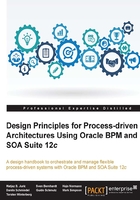
Which BPM game do we play?
Game Silo BPM is the workflow or business process automation in organizational departments. It resembles the kids playing soccer on the neighborhood playground. After a few years of experience with automated processes, the maturity rises to resemble your local football team—yes, they play in a stadium, and it is often not elegant.
Game Silo BPM is a tactical game in which work gets done while management deals with reaching departmental goals. New feature requests lead to changed or new applications and the people involved know each other very well over many years under established leadership. Workflows are automated to optimize performance.
Game Enterprise BPM thrives for process excellence at Champions League. It is a strategic game in which higher management and business departments outline the future capability maps and cross-departmental business process models. In this game, players tend to regard the overall organization as a set of more or less efficient functional capabilities. One or a group of functional capabilities make up a department.
Game Silo BPM – departmental workflows
Today, most organizations use BPM-based process automation based on tools such as Oracle BPM Suite to improve the efficiency of the processes within departments. These processes often support the functional capability that this particular department owns by increasing its efficiency.
Increasing efficiency is to do more with less. It is about automating manual steps, removing bottlenecks, and making sure that the resources are optimally allocated across your process. The driving force is typically the team manager, who is measured by the productivity of his team. The key factor to reach this goal is the automation of redundant or unnecessary human/IT interactions. Through process automation, we gain insights into the performance of the process. This insight can be called process transparency, allowing for the constant identification of areas of improvement.
A typical example of the processes found in Game Silo BPM is an approval process that can be expressed as a clear path among process participants. Often, these processes work on documents, thus having a tight relationship with content management. We also find complex backend integration processes that involve human interaction only in the case of an exception.
The following figure depicts this siloed approach to process automation. Recognizing a given business unit as a silo indicates its closed and self-contained world.
A word of caution is needed: The term "silo" is often used in a negative connotation. It is important, though, to recognize that a closed and coherent team with no dependencies on other teams is a preferred working environment for many employees and managers. In more general terms, it reflects an archaic type of organization that we lean towards. It allows everybody in the team to indulge in what can be called the siege mentality we as humans gravitate to some coziness along the notion of a well-defined and manageable island of order.

Figure 1: Workflow automation in departmental silos
As discussed in the introduction, there is a chance that BPM never leaves this departmental context in many organizations. If you are curious to find out where you stand today, it is easy to depict whether a business process is stuck in the silo or whether it's part of an enterprise BPM strategy. Just ask whether the process is aligned with corporate goals or whether it's solely associated with departmental goals and KPIs. Another sign is the lack of a methodology and of a link to cross-departmental governance that defines the mode of operation and the means to create consistent models that speak one common language.
To impose the enterprise architecture tools of Game Enterprise BPM on Game Silo BPM would be an overhead; you don't need them if your organization does not strive for cross-departmental process transparency.